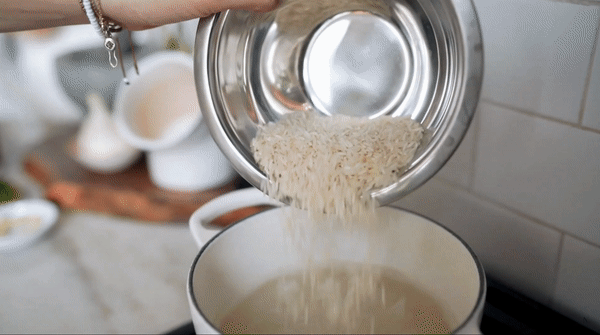Grains (especially ancient grains) have received quite a bit of attention over the past few years. They’re becoming more and more popular for their great nutrient profile including fiber, minerals, protein, and versatility in the kitchen.
Plus, they can be used on their own as a side, mixed into a salad or bowl, or even in a stuffed pepper — making it super easy to add to most meals! Grains are an awesome staple to not only have stocked in your pantry but also to have in your recipe box.
But are you getting bored with your go-to grain option?
Here are a few different types of grains to try as a way to mix it up and how to cook them!
How To Cook Grains
The only problem with grains is that they can be a bit confusing to cook. Almost every grain requires a different ratio of grain to water in addition to simmer time, which can quickly become overwhelming.
Here we’ll discuss all the nitty-gritty details on cooking grains so you feel confident enough to tackle them at home on your own.
Step 1: Rinse Your Grains
This first step is more important for food safety and taste than anything else.
Rinsing your grains before cooking them first helps to remove any dirt or excess starch that may be present on the outer layer. Depending on the particular grain, it may also help remove any unfavorable flavors.
Quinoa, for example, has an outer coating called saponin. When cooked it can create a bitter, almost soapy taste. Simply rinsing the grain with cold water removes this layer and therefore the undesirable taste with it!
Getting in the habit of rinsing all of your grains with cold water will keep them clean and bitter-free.
Step 2: Cook Your Grains
If you’re one for exact measurements and numbers, this section is for you. Many grains require different water to grain ratios and cooking times, so we’re listing them all here! We’ll walk you through the most popular whole grains and give you the best instructions for how to cook them.
(Note: not all of these options are gluten-free, but the ones with an asterisk are!)
Amaranth*
Bring 3 cups of water to a boil over high heat. Add 1 cup of amaranth, reduce heat to medium-low, cover and let simmer for 20 minutes or until all of the water is absorbed.
Brown Rice*
Bring 2 cups of water and 1 cup of brown rice to a boil over high heat. Reduce heat to medium-low, cover and let simmer for 40-45 minutes or until all of the water is absorbed.
Bulger
Bring 2 cups of water and 1 cup of brown rice to a boil over high heat. Reduce heat to medium-low, cover and let simmer for 15 minutes or until all of the water is absorbed.
Farro
Bring 3 cups of water and 1 cup of farro to a boil over high heat. Reduce heat to medium-low, cover and let simmer for 30 minutes or until all of the water is absorbed.
Millet*
Bring 2 cups of water to a boil over high heat. Add 1 cup of millet, reduce heat to medium-low, cover and let simmer for 20 minutes or until all of the water is absorbed.
Quinoa*
Bring 2 cups of water and 1 cup of quinoa to a boil over high heat. Reduce heat to medium-low, cover and let simmer for 15 minutes or until all of the water is absorbed.
Wild Rice*
Bring 3 cups of water and 1 cup of wild rice to a boil over high heat. Reduce heat to medium-low, cover and let simmer for 40-45 minutes or until all of the water is absorbed.


Cooking A Grain I Haven’t Listed? Use The No Measurement Method
Don’t worry! If you’re looking to cook a grain I haven’t listed, or if the descriptions above just seem too tedious or cumbersome, I have another method for you.
This method works for all grains, and pasta too!
All you have to do is bring one large pot of water to a boil, then add your grain. No need to measure the grain or the water, just estimate how much you think you need.
Keep the water boiling throughout the cooking process and test the grain for the desired texture as you go. We’re looking for an al dente texture – not too hard yet not too soft. Once done, just drain everything with a fine mesh strainer.
During the cooking process, the excess water in the pot actually helps to soak up any excess starch that would otherwise cause gumminess in your grain!
NS Recommends
Now that you know how to cook your grains, let’s talk about brands and tools! Here are some of our favorite kitchen must-haves for preparing and storing grains:
- Our favorite dutch oven for cooking grains
- The best glass containers for storage
Recipes To Try
Now that you’ve got the basics down pat, here are some recipes you can use to test out your skills and get some inspiration!
Show us your grain cooking skills on Instagram!
The next time you make a delicious grain at home, share it with us. You can show us by tagging @nutritionstripped and using #nutritionstripped!
We can’t wait to see your amazing meals!
The post 7 Whole Grains to Try and How to Cook Them appeared first on Nutrition Stripped.
from Nutrition Stripped https://ift.tt/2U0lIWQ

Post a Comment